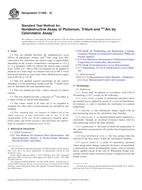Potřebujeme váš souhlas k využití jednotlivých dat, aby se vám mimo jiné mohly ukazovat informace týkající se vašich zájmů. Souhlas udělíte kliknutím na tlačítko „OK“.
ASTM C1458-16
Standard Test Method for Nondestructive Assay of Plutonium, Tritium and 241Am by Calorimetric Assay
Automaticky přeložený název:
Standardní testovací metoda pro nedestruktivní obsahem plutonia, tritium a & # x2009; 241 Am ze strany kalorimetrického testu
NORMA vydána dne 1.3.2016
Informace o normě:
Označení normy: ASTM C1458-16
Poznámka: NEPLATNÁ
Datum vydání normy: 1.3.2016
Kód zboží: NS-635228
Počet stran: 13
Přibližná hmotnost: 39 g (0.09 liber)
Země: Americká technická norma
Kategorie: Technické normy ASTM
Kategorie - podobné normy:
Anotace textu normy ASTM C1458-16 :
Keywords:
accountability, calorimetry, inventory, nondestructive assay, plutonium, quantification, tritium,, ICS Number Code 27.120.30 (Fissile materials and nuclear fuel technology)
Doplňující informace
| Significance and Use | ||||||||||||
|
5.1 This test method is considered to be the most accurate NDA technique for the assay of many physical forms of Pu. Isotopic measurements by gamma-ray spectroscopy or destructive analysis techniques are part of this test method when it is applied to the assay of Pu. 5.1.1 Calorimetry has been applied to a wide variety of Pu-bearing solids including metals, alloys, oxides, fluorides, mixed Pu-U oxides, mixed oxide fuel pins, waste, and scrap, for example, ash, ash heels, salts, crucibles, and graphite scarfings) 5.1.2 Pu-bearing materials have been measured in calorimeter containers ranging in size from about 0.025 m to about 0.63 m in diameter and from about 0.076 m to about 1.38 m in height. 5.1.3 Gamma-ray spectroscopy typically is used to determine the Pu isotopic composition and 241Am to Pu ratio (see Test Method C1030). However, isotopic information from mass spectrometry and alpha counting measurements may be used instead (see Test Method C697). 5.2 This test method is considered to be the most accurate NDA method for the measurement of tritium. For many physical forms of tritium compounds calorimetry is currently the only practical measurement technique available. 5.3 Physical standards representative of the materials being assayed are not required for the test method. 5.3.1 This test method is largely independent of the elemental distribution of the nuclear materials in the matrix. 5.3.2 The accuracy of the method can be degraded for materials with inhomogeneous isotopic composition. 5.4 The thermal power measurement is traceable to national measurement systems through electrical standards used to directly calibrate the calorimeters or to calibrate secondary 238Pu heat standards. 5.5 Heat-flow calorimetry has been used to prepare secondary standards for neutron and gamma-ray assay systems 5.6 Four parameters of the item and the item packaging affect measurement time. These four parameters are density, mass, thermal conductivity, and change in temperature. The measurement well of passive calorimeters will also affect measurement time because it too will need to come to the new equilibrium temperature. Calorimeters operated in power compensation mode maintain a constant measurement well temperature and have no additional effect on measurement time. 5.6.1 Calorimeter measurement times range from 20 minutes 5.6.2 Measurement times may be reduced by using equilibrium prediction techniques, by temperature preconditioning of the item to be measured, by operating the calorimeter using the power compensation technique, or by optimization of the item container (low thermal mass and high thermal conductivity) and packaging. |
||||||||||||
| 1. Scope | ||||||||||||
|
1.1 This test method describes the nondestructive assay (NDA) of plutonium, tritium, and 241Am using heat flow calorimetry. For plutonium the typical range of applicability, depending on the isotopic composition, corresponds to ~0.1 g to ~5 g quantities while for tritium the typical range extends from ~0.001 g to ~400 g. This test method can be applied to materials in a wide range of container sizes up to 380 L. It has been used routinely to assay items whose thermal power ranges from 0.001 W to 135 W. 1.2 This test method requires knowledge of the relative abundances of the plutonium isotopes and the 241Am/Pu mass ratio to determine the total plutonium mass. 1.3 This test method provides a direct measure of tritium content. 1.4 This test method provides a measure of 241Am either as a single isotope or mixed with plutonium. 1.5 The values stated in SI units are to be regarded as standard. No other units of measurement are included in this standard. 1.6 This standard does not purport to address all of the safety concerns, if any, associated with its use. It is the responsibility of the user of this standard to establish appropriate safety and health practices and determine the applicability of regulatory limitations prior to use. |
||||||||||||
| 2. Referenced Documents | ||||||||||||
|




 Cookies
Cookies
